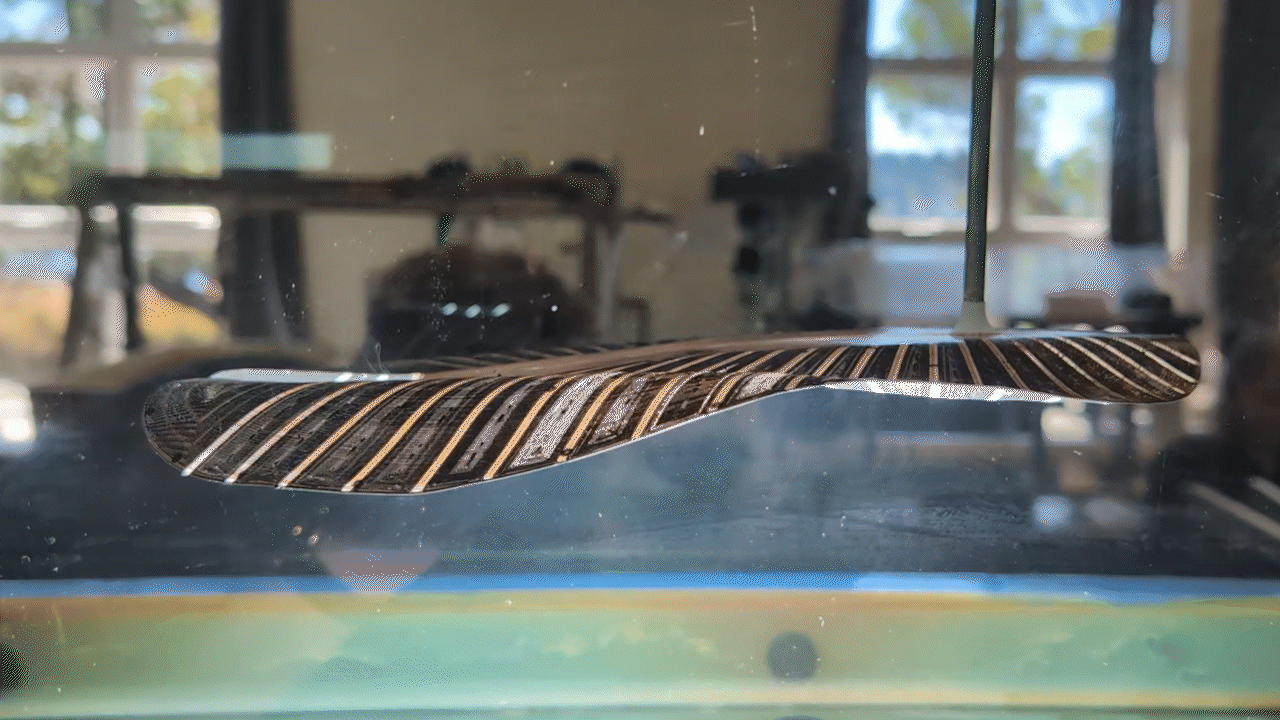- October 28, 2025
Unlocking Passive Dynamics: Batoid-Inspired Propulsion with ORCA™ Motors
University of Washington Application Story
In pursuit of understanding how nature’s most adept swimmers propel themselves in the water, researchers at the University of Washington are studying batoid-informed undulatory propulsion, the study of how propulsive systems mimic the traveling wave fin motions of rays and skates. The team is investigating how these undulatory motions allow batoids to glide with elegance and efficiency, across a wide range of body sizes and environments.

This project seeks to bridge the gap between biology and engineering by recreating the flapping dynamics of batoids in laboratory experiments. Early trials using a 7 degrees-of-freedom robotic arm proved noisy, imprecise, and difficult to control, limiting the team’s ability to capture meaningful force data. The introduction of Iris Dynamics’ ORCA™ Series Smart Linear Motor transformed their approach: its ability to operate smoothly within the critical 0.1 to 5 Hz frequency range, while offering flexibility in amplitude and force, allowed the team to replicate sinusoidal motions with unprecedented precision.
By combining physical models with thin membrane skeletons, and carefully controlled actuation, the research demonstrates how structural design alone can give rise to passive dynamics. This principle not only explains the effortless swimming of stingrays but also informs new directions for bio-inspired propulsion systems.
Definitions
Batoids: A group of fishes that includes rays, skates, and mantas, known for swimming with broad, undulating fins.
Degrees-of-Freedom (DoF): The number of independent ways a system can move. For a robotic arm, this refers to its joints and how they can rotate or translate.
Haptics: A control mode within IrisControls, that combines force, position, and velocity to simulate physical behaviours and generate smooth, lifelike motions.
Passive Dynamics: Motion that emerges from the structure and materials of a system without continuous active control, as in the natural flapping of a stingray’s fins.
Sinusoidal Motion: A smooth, wave-like oscillation that repeats regularly, shaped like a sine wave.
Undulatory Propulsion: Forward movement created by wave-like motions passing along a fin or body.
Flume: A long, narrow tank used in laboratories to generate and study currents under controlled conditions.
The Challenge: Achieving Smooth, Repeatable, and Configurable Motion Profiles in Batoid Propulsion Research
The goal of this project is to understand how batoids propel themselves through water. A central part of that question lies in the concept of passivity, the idea that a structure can generate or guide motion without requiring continuous active control. In batoids, the mineralized, segmented skeleton of the fins provides this property, allowing wave-like undulations to arise naturally. This is why even a dead stingray can flap in a lifelike way when moved through water, because its skeletal structure and soft tissues are inherently tuned to create that motion. Reproducing this effect in the lab means building flapping structures that demonstrate the same passive dynamics, where the right geometry and materials do the work rather than layers of control.
The team’s first attempts to capture this effect revealed the difficulty of the problem. They began by exciting 3D-printed/molded synthetic skeletons inside the Friday Harbor Lab’s flume using a 7DoF robotic arm. The approach quickly showed its limits. The machine introduced too much noise, produced inconsistent motion profiles, and generated jitter that overwhelmed the subtle forces they were trying to measure, leaving them with no meaningful force data. Instead of delivering precise, repeatable excitations, the robotic arm was too complex to control and introduced mechanical noise. With this method the researchers struggled to generate clean, repeatable sine waves, and the data they collected lacked the fidelity to capture meaningful insights into batoid propulsion.
ORCA-3-36V Linear Actuator as an Ideal Solution
Compact, Waterproof, Precise Force Control in a Wide Range of Amplitudes & Frequencies
Throughout early iterations of development, it was clear the 7DoF robotic arm would not produce the meaningful data the team required, so they pivoted to a different method of excitation, using a smart linear actuator. They required smooth, highly repeatable motions at lower frequencies, with the ability to deliver higher amplitudes and forces than their previous setup could achieve. Much of the relevant biology occurs at high frequency ranges that are difficult for typical actuators to achieve, and in this case the researchers required operation around 0.5 hertz.
Finding a device that could meet all of these requirements proved difficult. Many actuators on the market were either very fast but too weak, or strong but too slow. What the project needed was a dynamic solution with a wide operating band that would not constrain the research. The team needed the freedom to explore amplitudes and frequencies ranging from 0.1 to 5 hertz, especially since at the outset they did not know what range would ultimately be required.
ORCA-3-36V Fully-Integrated Linear Motor
This project utilized an ORCA-3-36V with a standard 9" shaft to meet it's requirements.
Iris Dynamics’ ORCA-3-36V linear actuator proved to be an ideal fit, balancing durability and flexibility in a compact waterproof package. It offered precise force control across the necessary frequency range, while also allowing large amplitude sweeps and high-speed movements. Its all-in-one motor architecture supported efficient data logging. The ORCA is by nature a force feedback actuator, enabling meaningful force measurements, giving the researchers confidence that they could adapt their experiments without changing hardware. As the motor was mounted above the flume tank, the IP68+ rating and waterproof nature was important for safe installation.
Equally important was the system’s ease of use. The plug and play nature of the ORCA motor allowed the group to integrate it quickly, which helped the project move forward without lengthy setup delays. Its versatility gave them freedom in how to position and configure their experimental apparatus, a quality that proved essential for a research program that continues to evolve.
Technical Specifications
| Flexibility to Linearize | ORCA Motors' shafts rotate freely within the chassis, however this research required the ability to constrain shaft rotation to ensure motion stayed one dimensional in the flume. The team easily achieved this by mounting frames and brackets. LINK to technical note. |
| Range of Amplitudes & Frequencies | Required flexibility to sweep amplitudes and operate from 0.1 to 5 hertz, with biologically relevant operation around 0.5 hertz. |
| Compact Size | With all drivers, sensors, and controllers included in the chassis of the motor, the ORCA-3 stator measures 89 x 85 x 70 mm (3.5 x 3.3 x 2.75 in). The standard shaft measures 229 mm (9 in) in length, with a 100 mm (4 in) usable stroke. |
| High Speeds | Reaching speeds up to 5.3 m/s. |
| Position & Force Resolution | The ORCA-3-36V offers position sensor resolution of ±250 µm, with force resolution (without external calibration) of 1 N. |
| Waterproof, IP68+ Rated Design | ORCA motors and cable glands are IP68 rated, suitable for installation over the flume. The chassis itself is fully epoxy potted. |
| Direct-Drive Architecture | Cogless design with a single moving part, eliminating backlash from gears, belts, or screws. |
| Integrated Sensing & Driver | All-in-one actuator with integrated motor driver, position and force sensing, and power delivery, so no external controller was required. |
Integration
The ORCA-3-36V was mounted above the flume in a custom 8020 T-Slot frame. 3D-printed brackets were used to keep the shaft linearized and one dimensional, with the shaft extending towards the water. A sting was attached to the shaft, connecting the linear motor to the top of the underwater test body. The team further validated force inputs by tracking a marker dot on the sting and using its deflection as a proxy, rather than relying solely on the onboard force sensor. Experiments were carried out in both static and continuous flow conditions within the tank. For control, the group primarily relied on Python scripts and the IrisControls software package.
Using IrisControls, the team leveraged Haptic Mode to produce smooth and consistent sine waves. This mode integrates position, velocity, and force to simulate physical behaviours, enabling precise oscillations and adding a layer of control beyond standard force control. With positional streaming and built-in data logging, they could reliably collect and analyze test results, enhancing their workflow.
.png?width=808&height=586&name=ActuatorImage2%20(1).png)
Linearlized ORCA Motor with mounting points.
Final Thoughts
The transition from the 7DoF robotic arm to the ORCA-3-36V linear motor was critical for the success of this project. Where the robotic arm introduced jitter, inconsistent motion profiles, and noise, the ORCA motor delivered smooth, repeatable oscillations in the critical 0.1 to 5 hertz range in a compact and quiet package. This shift eliminated motion inconsistencies that had obscured force measurements and gave the team confidence that the data reflected the underlying physics rather than the limitations of their hardware. With the ORCA’s precision, force feedback, and integrated sensing, the researchers were able to recreate lifelike undulatory motion in the flume and capture the passive dynamics that define batoid propulsion. The work underscores how the right actuation technology can bridge the gap between biology and engineering, moving an idea from proof-of-concept to meaningful discovery.
Testimonial
“There are plenty of linear actuators that are really really fast, but they’re all too weak. There are plenty that are ridiculously strong and they’re all too slow. We needed something that had a wide band of available amplitudes. The ORCA motor gave us total freedom to pick our amplitude and frequency within the kinds of ranges we worked within.”
- John Michaels, Project Lead

.jpg?width=333&height=442&name=Rig_deceased_skate%20(1).jpg)